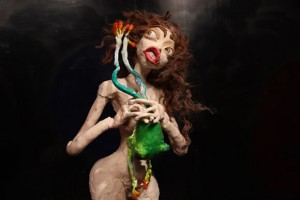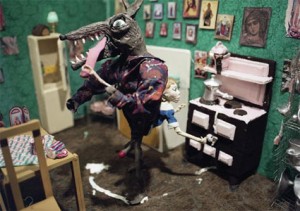Upon entering Nathalie Djurberg’s (1978) exhibition (Boijmans, 2011) one cannot avoid a sense of bewilderment. Set up around stop-motion claymation video’s of mostly naked figures dancing delightedly, flirting intimately and toying tenderly with the most gruesome of animals or each other, the exhibition seems to travel some well-trodden grounds. All too familiar themes such as sex, power and violence seem to be handled by means of a series of graphic scenes, culminating towards obscene finales. One video shows a man attempting to dance with a snake before he gets ripped apart; another clip shows innocent-looking daughters approaching their mother’s bedside to crawl back in her womb. A next animation tells the story of a young Eskimo-girl hunting for a walrus so she can disembowel the formless creature and sew herself in its skin. And yet other films show girls sensually stripping off each other’s flesh, monks and a donkey sucking dry the breasts of Rubens-like female or various insects crawling over a corpse.
Shocking? Not really. We have seen too much of it already. After the first bored looks at yet another show that seems to revisit former no-go areas that have for long been artistic clichés, you start to realize, however, that there actually is something very intriguing about the exhibition – very intriguing, indeed. For Djurberg is at least as interested in leaving the beaten track – or rather: transcending it through otherworldly rituals or imaginary worlds. Her work is moreover animated – and driven forward – by the oscillations between such poles as immanence and transcendence, innocence and corruption, tenderness and gruesomeness, idylls and monstrosity, reality and fantasy, pain and pleasure, sobriety and indulgence, and so on and so forth. And the accompanying music composed by Hans Berg – already worth the visit itself – adds an uplifting pulse and an atmospheric quality to the animations.
As said, the videos and sculptures of the principal installation, Snakes Knows it’s Yoga, are littered with references to those otherworldly aspects of mysticism, meditation and hallucination. Men and women lose themselves in carnal pleasures and hallucinate on unfamiliar substances; faqirs meditatively ascend to the heavens, lay on a bed of nails or attempt to hypnotize a snake (or vice versa). Strikingly, her older works (2005-2010) points towards an obsession with the features of those other worlds created by fairytales, fables and folk tales. A hairy caveman turns on some girls in a dollhouse-like universe (Caveman Mike, 2008); the bodies of a giant wolf and a petite girl are symbiotically grown into one another (We are not two, we are one, 2008); a luscious female dies while being lost in a grim forest, upon which the insects dutifully decompose her body (Turn into me, 2008). Fittingly Djurberg describes her work as pagan poetry or fairy tales gone mad, nicely encapsulated by an animation of a voluptuous woman lusciously licking either a hallucinatory toad used in shamanistic rituals or a frog that is about to turn into a prince (or Caveman Mike, of course). Highly recommended!
image #1: Snakes Knows it’s Yoga. Boijmans/Djurberg; image #2 : We Are Not Two, We Are One. Frye Art Museum/Djurberg.


